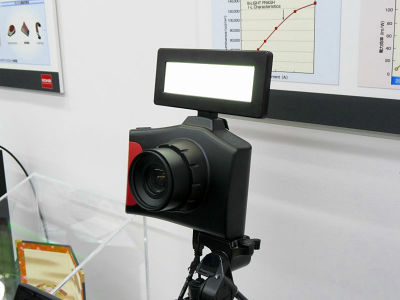Introducing a fierce man who created a high-magnification laser microscope from a DVD drive

DVD-Drive based Laser Scanning Microscope [Lötlabor Jena]
https://loetlabor-jena.de/doku.php?id=projekte:dvdlsm:start
'In recent years, DVD drives have been scrapped in large numbers, so hardware enthusiasts can get them almost free of charge,' said Jena, using cheap DVD drives. Plan to create some kind of hardware. I came up with the idea of creating a laser microscope using a laser sensor that is capable of identifying the height of 440 nm pits placed at 780 nm intervals on a DVD disc.
According to Jena, the DVD drive unit includes not only a high-precision laser sensor, but also optical elements such as lenses, mirrors, and prisms necessary for creating a laser microscope, and mechanisms such as a motor that moves the sensor to the appropriate position. Because it is, it is suitable for making a laser microscope. However, the DVD drive is equipped with a unique microprocessor and circuit designed by the manufacturer, and the user cannot rewrite the operation without permission. Therefore, Jena decided to reverse engineer the hardware and design her own software and hardware to add the focus function and sensor position adjustment function required for laser microscopes.
The DVD drive is equipped with a photodiode integrated circuit (PDIC) that detects and processes the laser light. Jena took the PDIC out of the DVD and attached it to the breakout board for easy handling.

Next, Jena took micrographs to understand the structure of PDIC. As a result, it became clear that PDIC has at least eight independent photodiode channels.

After that, Jena confirmed the role of each photodiode channel by irradiating light of various brightness while measuring the voltage of PDIC.

Understanding the design of the PDIC, Jena designed the board to handle the information received from the PDIC, control the motor that adjusts the position of the sensor, and supply power. The board designed by Mr. Jena is equipped with the IC chip '

In addition, Jena also developed software to control the position of the sensor. I created a laser microscope from a DVD drive.

Jena also publishes photos taken with the laser microscope she created. When the following electronic chips are photographed with a laser microscope created by Mr. Jena ...

You can enlarge the range of 1mm x 1mm and shoot like this.

It is also possible to shoot at a higher magnification. The image below is the upper right part of the above image taken on a scale of 500 μm x 500 μm.

The laser microscope created by Mr. Jena this time takes several minutes to several hours to shoot. 'We were able to make a pretty good laser microscope without spending too much money,' Jena said with satisfaction.
In addition, Jena publishes the blueprints and source code developed for creating laser microscopes in her GitLab repository .
Related Posts:
in Hardware, Posted by log1o_hf







